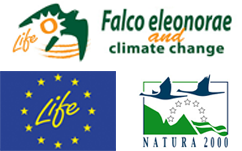Past project of Falco eleonorae
The program began on March 1, 2003 and ended on 31 October 2007 and was undertaken by the Hellenic Ornithological Society.
The aim of the program was to coordinate and implement priority actions for effective and long-term preservation of the population of Eleonora’s Falcon (Falco eleonorae) in Greece. Until the project began, it was known that about 90% of the world population of the species breeds in Europe and 70% in Greece. We now know that at least 84% of the world population breeds in Greece, so the responsibility of our country for the protection of the species is greater than of any other country.
The Hellenic Ornithological Society, the Greek partner of Birdlife Inrternational, in collaboration with the Natural History Museum of Crete (NHMC), the British Ornithological Society RSPB (Royal Society for the Protection of Birds) and the Directorate of Aesthetic Forests, National Parks and Hunting of the Ministry Agriculture, through the implementation of the program aimed at promoting the conservation of the species in Greece with the implementation of measures in the major colonies of the species, in islets and the surrounding area of 10 Special Protection Areas (SPAs) in the Aegean.
During the course of the project various concrete conservation measures were implemented, including the implementation of the first world population census, application of wardening schemes in the most threatened sites to minimize human disturbance in falcon colonies, application of pilot management measures to enhance the breeding habitat quality (including the first rat eradication operation in the Aegean Sea), implementation of public awareness campaign and establishment of network across the Mediterranean countries. These actions resulted in (i) the update of knowledge on the precise location of the species’ breeding colonies (confirmation of past references, discovery of several new ones), (ii) estimation of breeding success in key colonies and the factors affecting it, (iii) identification of main prey items during the breeding period. The project was nominated by EC as one of the best Life Nature projects for 2008.
For more information you can visit the project’s website:

 Ελληνικά
Ελληνικά English
English